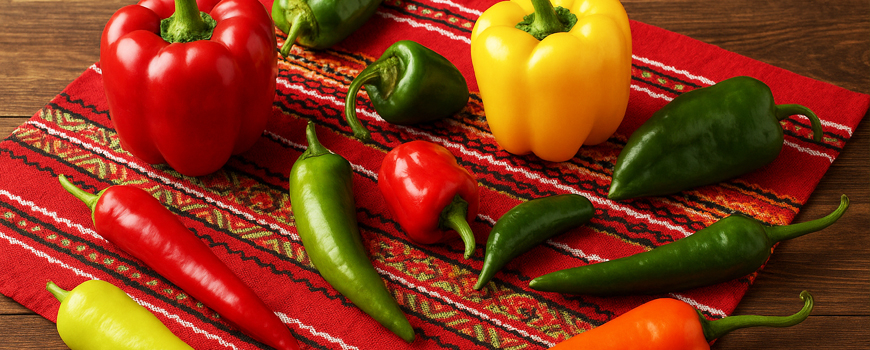Peppers are the fruit of the plant Capsicum annuum - from the same family as tomatoes and eggplants. Originally from the Americas, they reached Europe after Columbus’ voyages and quickly became a beloved part of Balkan cuisine.
From the New World to Bulgaria
This American “immigrant” settled in Bulgaria in the 19th century and soon became a staple crop. A milestone came in 1894 in Kurtovo Konare, where the first kilogram of ground red pepper was produced. The local variety, Kurtovska Kapiya, is still celebrated today with a yearly festival of peppers and tomatoes.
Bulgarian Varieties at a Glance
Bulgaria takes pride in its diversity of peppers: Kapiya, Babura, Kamaba (ratund), Sivriya, Chorbajiyska, and the fiery Shipka. The Maritsa Vegetable Crops Research Institute in Plovdiv continues to develop modern Bulgarian varieties, ensuring peppers remain at the heart of our kitchens.
Why Peppers Are So Good for You
Color = nutrients
Red peppers are rich in vitamin C and carotenoids like capsanthin, green ones carry more lutein, while yellow-orange peppers bring zeaxanthin - all great for immunity and eye health.
Vitamin C + iron boost
Eating peppers helps the body absorb plant-based iron from beans and leafy greens.
Fiber and hydration
Crisp, juicy, and filling, peppers add volume to meals without weighing you down.
Varieties and Their Perks
Kapiya (incl. “Kurtovska”): Aromatic, meaty, perfect for roasting, spreads, and the famous lutenitsa - bursting with antioxidants.
Babura & Kamaba (ratund): Thick-walled, hollow - ideal for stuffing and pickling.
Sivriya: Long, pale green, tender - a favorite for frying and fresh salads.
Chorbajiyska & Shipka (hot): The “spicy pharmacy” - thanks to capsaicin, though its safe use is in controlled medical products, not home remedies.
Health Benefits and Conditions Where They Help
Nerve pain (after shingles, etc.): High-dose capsaicin patches (applied in clinics) can reduce pain in some patients.
Osteoarthritis: Over-the-counter creams/gels with capsaicin are recommended in British arthritis guidelines for knee pain relief.
Non-allergic rhinitis: Prescription nasal sprays with capsaicin sometimes help chronic runny noses.
Iron absorption: Combine peppers with beans, lentils, or spinach - vitamin C boosts plant-iron uptake.
Safety note: Homemade poultices with hot peppers can cause severe skin irritation or burns. For joint or nerve pain, always use regulated pharmacy products.
Bulgarian Traditions on the Table
The smoky aroma of roasted red peppers defines late summer. From there comes lutenitsa, kyopolou, ajvar-style spreads, stuffed peppers, “chushka burek”… In Kurtovo Konare, the pepper is so iconic it has its own annual festival.
Easy Everyday Uses
Breakfast: Wholegrain bread with cheese, roasted kapiya, and a drizzle of olive oil.
Lunch: Salad with roasted peppers, tomatoes, and parsley, dressed with lemon.
Dinner: Stuffed peppers (rice + veggies, or rice + minced meat) with yogurt on the side.
Preserves: Roasted, peeled red peppers in jars with garlic and vinegar - a ready garnish year-round.
Folk Medicine & Home Beauty - What’s Reasonable
In tradition: Hot pepper poultices were once used, but today we know pharmaceutical capsaicin creams and patches are far safer and more effective.
In home cosmetics: Pureed sweet red peppers (not hot!) mixed with yogurt makes a refreshing face mask - but always patch test first. Still, the best cosmetic benefit of peppers comes from eating them, thanks to vitamin C and antioxidants.
Peppers are colorful, fragrant, and deeply Bulgarian - from the fire of the grill to the jars of preserves on the shelf. Each color has its own antioxidants; hot peppers hold medical promise when used properly; but the surest benefit comes from this simple habit: eat more peppers - roasted, stuffed, or fresh - and enjoy their flavor and health power.



